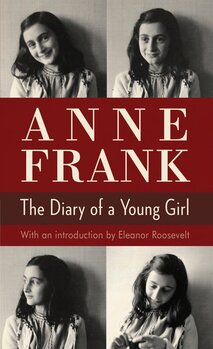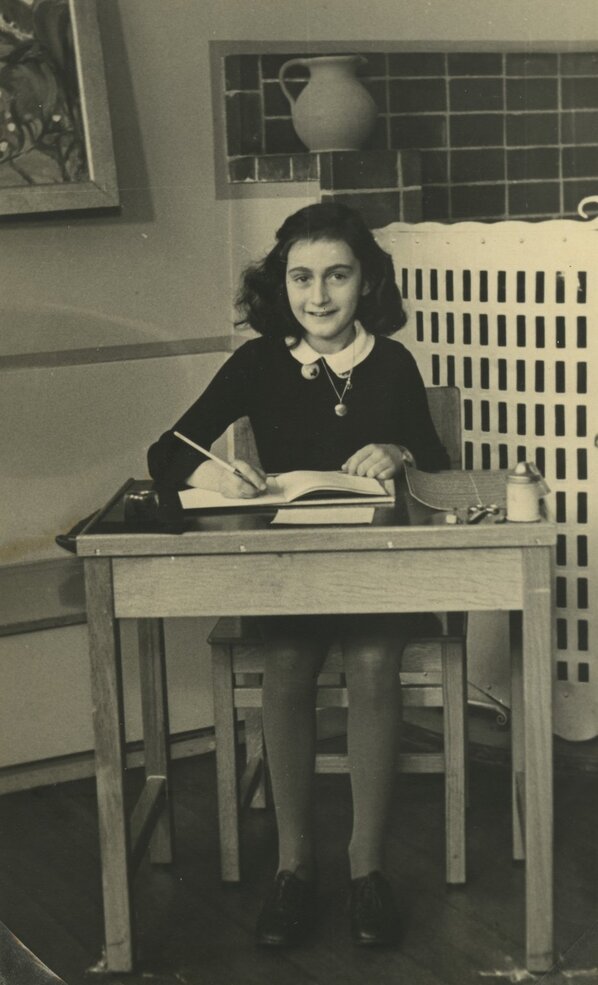 Anne Frank: The Diary of a Young Girl by Anne Frank ISBN: 978-0141315195 Publisher: Puffin Books Copyright Date: 1947 Reading Age: 12-15 Reading Level: Grades 9-12 Genre: Young Adult Biography Subgenre: Epistolary Plot Summary On Anne Frank's 13th birthday, she received a diary as a gift. Soon after, she and her family went into hiding to avoid being captured and sent to concentration camps. For two years, they and another family spent every moment of their lives in a 450 square foot secret annex. Anne writes about her experiences with honesty, wit, and innocence. While dealing with boredom, hunger, and constant anxiety, she and the others continued to live their lives until their discovery. While only her father Otto and her diary survived, her writing continues to impact those who read it. Anne's story humanizes the experiences of Jews during World War II and the atrocities committed by the Nazis. Critical Evaluation There is a culture of denialism about the deaths and hardships caused by Nazis in the countries they occupied during World War II. On some level, this is understandable, as an act as horrific as the Holocaust is hard to fathom. But it did happen, and stories about genocide are important to include in a collection so that when rumblings of the same sorts of behaviors begin to show again, they can be recognized and stopped before they can take hold. Such is the importance of The Diary of Anne Frank. It is an honest diary written by a young person who was living in constant fear but also continued to live her life. It brings a feeling of connection and completely humanizes a time that may seem like the distant past to modern teens. The previous year of lockdown and being stuck inside homes brings a new relevance to teens who are introduced to this book for the first time. While they by no means experienced the levels of hardship and fear that the Frank and Van Pels families, there is now a level of built-in empathy for the concepts of constantly being scared by a thing that you cannot control as well as not being allowed to participate in the greater world. The Diary of Anne Frank is a classic, and unfortunately, the tragedy of a life cut short by hatred is a story that continues to be told over and over again. Through reading this diary, hopefully teens can see just how monstrous acts of hatred can be. It is easy to identify with Anne. She shows the naivety of many teens, dreams about her first kiss, falls in and out of crushes, and continues to live her life no matter the challenges. Anne's story is one of strength, perseverance, and continuing to be creative no matter the odds. The fact that the odds don't always end in your favor, that real life doesn't always have a fairy tale ending, makes Anne's story one of light and light lost. Reader’s Annotation Imagine being thirteen, hunted by a group of people who hate you even though they don't know you, so you go into hiding. What would you think about; how would you live?  About the Author Anne Frank was born in the German city of Frankfurt am Main in 1929. Anne’s sister Margot was three years her senior. Unemployment was high and poverty was severe in Germany, and it was the period in which Adolf Hitler and his party were gaining more and more supporters. Hitler hated the Jews and blamed them for the problems in the country. He took advantage of the rampant antisemitic sentiments in Germany. The hatred of Jews and the poor economic situation made Anne's parents, Otto and Edith Frank, decide to move to Amsterdam. There, Otto founded a company that traded in pectin, a gelling agent for making jam. On 1 September 1939, when Anne was 10 years old, Nazi Germany invaded Poland, and so the Second World War began. Not long after, on 10 May 1940, the Nazis also invaded the Netherlands. Five days later, the Dutch army surrendered. When Margot received a call-up to report for a so-called ‘labour camp’ in Nazi Germany on 5 July 1942, her parents were suspicious. They did not believe the call-up was about work and decided to go into hiding the next day in order to escape persecution. In the spring of 1942, Anne’s father had started furnishing a hiding place in the annex of his business premises at Prinsengracht 263. He received help from his former colleagues. Before long, they were joined by four more people. Anne started writing and rewriting her diary, but before she was done, she and the other people in hiding were discovered and arrested by police officers on 4 August 1944. The police also arrested two of the helpers. To this day, we do not know the reason for the police raid. Despite the raid, part of Anne’s writing was preserved: two other helpers took the documents before the Secret Annex was emptied by order of the Nazis. She was deported first to Auschwitz-Birkenau then to the Bergen-Belsen concentration camp with Margot. Their parents stayed behind in Auschwitz. The conditions in Bergen-Belsen were horrible too. There was a lack of food, it was cold, wet and there were contagious diseases. Anne and Margot contracted typhus. In February 1945 they both died owing to its effects, Margot first, Anne shortly afterwards. Anne’s father Otto was the only one of the people from the Secret Annex to survive the war. He was liberated from Auschwitz by the Russians and during his long journey back to the Netherlands he learned that his wife Edith had died. Once in the Netherlands, he heard that Anne and Margot were no longer alive either. (About the author and image from here.) Booktalking Ideas
We have all experienced being stuck inside, especially during the Lockdown, but it most likely wasn't nearly as tight as eight people in 450 square feet. Do a tour of a room with the same approximate space. Discuss the theories behind "Dear Kitty." Challenge issues: teen sexuality, smoking, violence Challenge Issue Resources: Nevada County Library Selection Policy Selection of materials is based upon a number of criteria that include:
The Library selects materials in accordance with the guidelines stated by the American Library Association in its Library Bill of Rights, and Freedom to Read Statement and Freedom to View Statements. The Library supports diversity of expression and views in its collection in an attempt to provide patrons with a foundation for making informed decisions and formulating personal opinions. The Library does not exclude items because of the race, nationality, social, political, or religious views of the authors. The presence of controversial materials in the collection does not represent the Library’s endorsement of the opinions expressed therein. Although some materials selected may contain language and/or illustrations that may be offensive to some patrons, the Library cannot undertake the task of pleasing all individuals by censoring such items. Active Listening Skills Staff should listen calmly to the patron’s concerns without judgement or commentary. They should acknowledge the public’s right to challenge materials and help the patron find an alternative item that will fit their needs. Nevada County Library Reconsideration form Any citizen may challenge materials. If the citizen chooses to submit a written Request for Reconsideration of Library Materials, Library staff will collect reviews and accumulate data on how the material conforms to the selection policy. An ad hoc review committee consisting of the Library Director, Branch Manager, one other librarian, and a citizen appointed at the discretion of the Library Director will review the material, judge whether it conforms to the Selection Policy and submit its report in writing to the Nevada County Board of Supervisors. Concerned parties will be notified of the final decision in writing. ALA Strategies and Tips for Dealing with Challenges to Library Materials ALA Bill of Rights on Intellectual Freedom The American Library Association affirms that all libraries are forums for information and ideas, and that the following basic policies should guide their services. Why Included - This is an honest diary written by a young person who was living in constant fear but also continued to live her life. It brings a feeling of connection and completely humanizes a time that may seem like the distant past to modern teens. The Diary of Anne Frank is a classic for a reason. The tragedy of a life cut short by hatred is, unfortunately, a story that is told over and over again, but through this diary, teens can see how much people can live—even in a restrictive environment—and just how monstrous acts of hatred can be. |